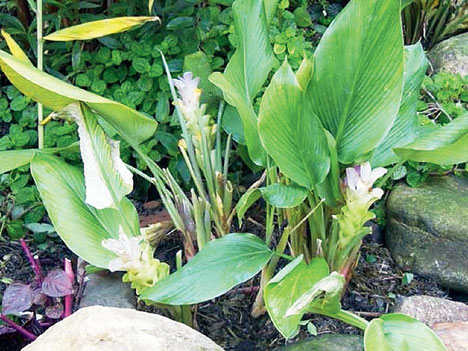

The Ginger is an indispensable herb but today we learn to grow two lesser-known types of Ginger - the Mango Ginger and Red Ginger.
Mango Ginger, called Amada in Bengali, is pale yellow on the inside with even lighter colour outside and when crushed, smells like raw Mangoes. This makes it a basic ingredient in pickles, preserves, candies, sauces and chops. It also has medicinal properties.
The Mango Ginger plant has similarities with the Turmeric plant, but its crop duration is shorter, of about six months. It grows to a height of a metre and has long leaves. Each plant bears five or six pairs of leaves and the rhizomes are fleshy, five to 10cm long and two to 5cm in diameter. They emulate the raw Mango flavour and are pungent in taste.
Amada is found as wild growth in parts of Bengal, Gujarat, Odisha, Kerala, Karnatak and Tamil Nadu.
Climate and soil- Hot and humid tropical climate with high rainfall is best for this plant. Generally it grows in open conditions but can tolerate low levels of shade. So a partially shaded portion of the garden may be used for its cultivation.
The plant grows well in sandy loam soil enriched with farm yard manure (FYM) with provision for good drainage. The cultivation of Amada is similar to that of Ginger, but some salient points are discussed below.
Preparation of land- The bed should be brought to fine tilth between February and March, subject to the availability of pre-monsoon showers. The beds should be of convenient length usually 3-5m with 1.2m wide with 40cm spacing in between.

Propagation- Well-developed, healthy and disease-free whole or split rhizomes, weighing 15- 20g are suitable for planting. In most places, local varieties are used for cultivation.
Planting- Mango Ginger is mostly planted in April with the commencement of pre-monsoon showers. Small pits are dug with a hand hoe on the beds with a spacing of 30cm. Pits are filled with well-decomposed compost.

The crop is immediately mulched with green leaves. This will reduce weed growth and conserve soil moisture. However depending upon the soil moisture, supplementary irrigation is required.
Harvesting- Rhizomes are ready for harvesting after seven or eight months of planting. Uproot the entire plant, cut the top and collect the rhizomes. After cleaning the harvested rhizomes, dry it under shed for two or three days.
Medicinal use- The extract of Mango Ginger is used as appetiser, antipyretic and for treating skin diseases. It is also used against inflammations of the mouth, ears, ulcers, jaundice and some infections.

Red Ginger
The Red Ginger variety, with its colourful flowers, makes a great landscaping plant. They are commonly used as an ornamental plant in Asia, particularly in East Asia, for their elegance of form, colourful flower heads and texture. Their ability to thrive in partial shade makes them ideal for specific situations. Moreover, Red Ginger is easily grown and maintained.
There are three floriculturally important genera of Mango Ginger, namely Alpina, Etlingera and Gingiber. Out of these the Red Ginger (Alpina purpurata) is the most popular. This variety is beautiful and so has become a favourite ornamental and cut flower, both for the homes and commercial purposes.

Red Ginger is a tall upright plant that grows well in fertile, organically rich, moist and well-drained, almost neutral soil.
Flowers are harvested early morning and should be cut when the bracts are two-thirds to three-fourths open. Post-harvest, its life may be increased by using floral preservative or by simply cutting the stem a little.
S.K. Maiti, patron of Bidhannagar Horticultural Society and a civil engineer residing in FC Block, offers guidance on choosing herbs to suit Salt Lake’s soil and climate
• To be continued











